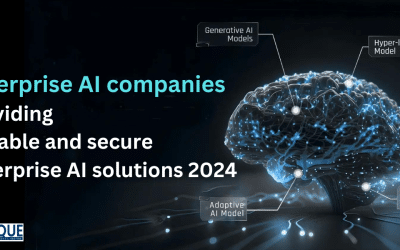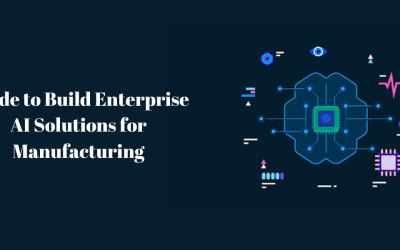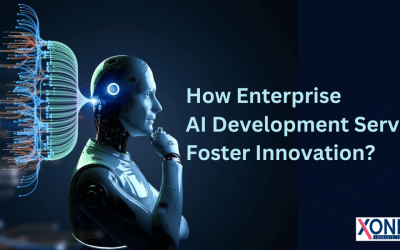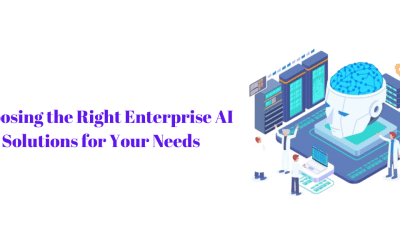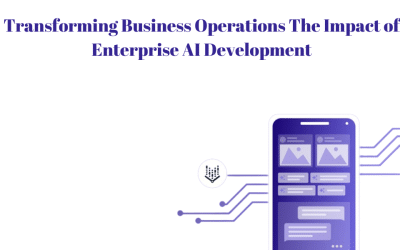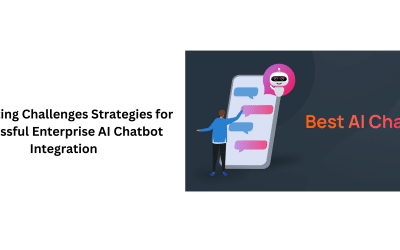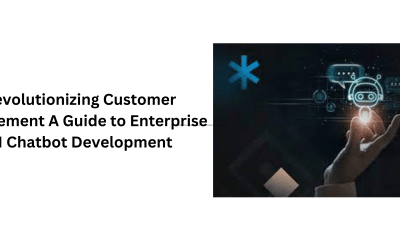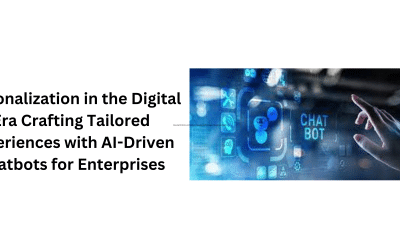In today’s world, digital transformation has become the top priority for virtually every industry, and this development continues at an accelerated pace. Companies that used to rely solely on manual processes are slowly embracing automation. Artificial intelligence can achieve all this. As more and more businesses spend money on AI, Enterprise AI Solutions and traditional AI are emerging as two sides of a coin.
You might now be thinking about what is enterprise AI and traditional AI. In the shortest sense, it can be described as Enterprise AI, a machine learning application and artificial intelligence used to perform routine business tasks. In contrast, traditional AI is a subset of artificial intelligence that concentrates on executing preset tasks utilizing specific algorithms and rules. They are usually taught on massive datasets and can recognize patterns in the data. They use those patterns to formulate predictions or to generate outputs.
Understanding the fundamental differentiators between these two forms of AI is essential for any business looking to improve its processes using AI technology. This piece will explore the main differences and advantages of enterprise AI and conventional AI. Let’s examine the differences!
What Is Enterprise AI?
Enterprise AI, also known as Enterprise Artificial Intelligence, refers to implementing artificial intelligence (AI) methods and technologies in large companies or organizations to boost the quality of their operation, decision-making processes, and customer interaction. This involves using AI machines, tools, algorithms, natural language processing, and other AI-related technologies to tackle specific business issues. It also helps improve an organization’s overall efficiency, productivity, and competitiveness.
Numerous corporate managers need help with the advantages and disadvantages of integrating earlier technological advancements, including blockchain. AI burst into the spotlight as the dust settled over the blockchain’s use. There is a lack of understanding about how neural networks work and an inability to comprehend the business implications of how they could impact business. This has left executives with a tidal wave that is a combination of FOMO (Fear of Missing out) and FOCICAD (Fear of Causing Unforgivable Destruction and Chaos). How can business executives navigate Enterprise AI without losing their foundations and possibly harming their companies? It’s in combining traditional processes in business and quality control with the latest additional technologies that can mitigate the dangers associated with AI and its results.
Key Characteristics Of Enterprise AI
Enterprise AI contributes to many aspects of an organization, from data analysis to automation. The result is diverse techniques, methods, and methodologies, which can be unique for each sector or company. This is how it operates:
Combination Of AI Technologies For Enterprise Applications
There are various AI techniques that could be used for business applications. Enterprise AI Development Company employs various technologies, such as machine learning, natural language processing, edge computing, deep learning, computer vision, and many more. They provide efficient capabilities that aid companies with tasks like visual recognition, predictive analytics, and image recognition. Netflix’s recommendations, which utilize techniques similar to deep learning, are one of the most prominent examples.
Tailored And Designed To Meet Organizational Needs
AI enterprise is a blend of different technologies. Depending on the business’s requirements, an organization decides the best method and approach to implementing AI within the framework. What works to manage supply chain operations may not be the best option for e-commerce.
For example, enterprise AI companies in health care employ imaging analysis, patient monitoring, etc., to improve effectiveness in the medical field. Energy companies employ methods and technologies such as predictive maintenance, integration of renewable energy sources, and many more to maximize energy production and consumption. The difference in power can result in organizations navigating the various areas influenced by artificial intelligence.
Enterprise AI Use Cases
Enterprise AI is an excellent tool for businesses to enhance customer service and can become a potent device to increase sales. Virtual chatbots can track customer behavior and improve interactions between companies and customers, allowing companies to increase service offerings and boost sales.
Improved Operational Efficiency And Productivity
One of the most significant benefits of Enterprise AI is that it can automate repetitive and time-consuming chores, freeing up some of the burden on workers’ hands and freeing them up to focus on more strategic and vital tasks. The system streamlines processes, decreases the chance of errors made manually, and boosts the efficiency of operations across different areas and departments, such as supply chain and human resource management. It’s an essential tool for productivity.
Enhanced Decision-Making And Predictive Capabilities
Enterprise AI companies make well-informed decisions based on extensive knowledge by analyzing massive data sets quickly and forecasting trends and risks. This helps to identify patterns, trends, and correlations that may not be apparent in the first place, allowing for greater accuracy and efficiency in decision-making. E-commerce is an illustration of this. It uses artificial intelligence to gain information from customer behavior, search results, and purchases. This helps businesses offer specific offers and options for searching for their clients, improving overall customer experience.
Automation Of Repetitive Tasks And Workflows
From Tesla’s buzz about self-driving cars to Amazon’s Alexa, there are various examples of how AI can be utilized to provide quicker and more efficient solutions for people of all ages. Enterprise AI is helping businesses reduce the amount of data collected and processing times. The technology not only helps save time but also improves processes, which allows the groups to concentrate on jobs that require human interaction.
Streamlined Data Analysis And Insights
AI algorithms are known for rapidly analyzing vast amounts of data, finding patterns and anomalies that reveal trends and risks. Companies using AI for enterprise can look over patterns and gain actionable insight by conducting a thorough analysis. Given the amount of available information, human beings cannot do this. This ultimately improves decision-making, frees employees’ time to focus on more important work, and gives them an advantage over rivals. This is highly beneficial in areas more susceptible to threats, i.e., the finance industry.
What Is Traditional AI?
Traditional Artificial Intelligence, also known as an expert or rule-based AI, is a type of AI based upon predetermined rules and algorithms to carry out specific tasks and make decisions. It is specifically designed to excel in a particular project or even a limited set of specific tasks. Traditional AI was created to perform well in one task or a limited number of activities. Some examples of well-known AIs include automated speech recognition (ASR), voice assistants such as Siri or Alexa recommendation engines found on Netflix or Amazon, and Google’s search algorithm. Each has been trained to comply with particular rules when providing data, but it only creates something new.
Therefore, it is effective for domains with established and stable rules, such as game-playing AI, professional medical diagnosis, and industrial automation. Simple, Traditional AI helps in prediction-making tasks, automation of work, and solving problems. Although traditional AI remains widely utilized, generative AI is quickly being adopted as the primary technology by numerous.
Key Characteristics Of Traditional AI
The primary characteristics of regular AI consist of:
Programmed Intelligence
Traditional AI relies upon pre-programmed algorithms and rules. The AI system offers solutions and works with an algorithm developed by a programmer.
Application Restrictions
The AI models were created with a particular task in mind, limiting their range of applications.
Analysis Of Data
Traditional AI is focused on analyzing data in a set and then formulating predictions based on this Analysis. It Is An Excellent Tool For Forecasts And Different Data Analyses.
Learning Capabilities Are Limited
The capabilities to learn about Narrow AI are limited and dependent on the types of data inputted by the AI’s creator.
Traditional AI Use Cases
Traditional AI, or narrow AI, applies artificial intelligence to specific jobs or fields. For projects-based companies, Traditional AI can be used for a myriad of purposes to increase efficiency, productivity, and decision-making procedures:
Predictive Analytics
Traditional AI analyses historical data and patterns, allowing for precise predictions regarding future project results. Through the use of predictive analytics, project managers can identify possible risk factors, calculate the amount of resources needed, and enhance project timetables. Businesses can make informed decisions and allocate funds efficiently, leading to improved project results.
Automatization Of Repetitive Routine
Businesses based on projects often have tedious and lengthy jobs that could be automated with conventional AI. The technology can streamline tasks, including data entry, report generation, and task assignment, opening precious time for team members to concentrate on other important tasks. Automation boosts efficiency, lowers the chance of human errors, and ensures greater accuracy during process execution.
Virtual Assistants
Virtual assistants run using conventional AI and can aid project managers and team members differently. They can assist with planning, scheduling, and reminders, as well as prioritizing tasks, making sure that projects are on the right track. Virtual assistants also offer instant updates, create reports, and respond to questions, allowing project teams to access information quickly and effectively. The technology improves communication and cooperation among project teams, increasing performance and project results.
Speech Recognition And Image Recognition
Traditional AI methods like image or speech recognition are used in projects-based organizations to improve procedures and increase efficiency. In particular, image recognition is a way to detect the progress of projects through an analysis of the construction site or manufacturing procedures. Speech recognition is an excellent tool for updating projects using voice, which allows team members to communicate current information in real-time without manual entry.
Traditional AI vs Enterprise AI
The primary differentiator between enterprise AI and regular AI is their purpose and how they are used. Enterprise AI is focused on solving specific applications with high value on an enormous scale. The largest companies frequently interact with hundreds of software applications and create vast information. Because of the sheer size and volume of data it generates, the enterprise’s AI is uniquely placed to process large volumes of information. Companies often need to update their technology stack to accommodate the vast data required for the models.
Enterprise AI is also distinguished from conventional AI due to its capability to work with other business systems and applications, including Salesforce, ServiceNow, and Workday. Additionally, it typically has an API that allows it to integrate seamlessly with different parts of an organization’s tech stack, allowing it to grow. Furthermore, an enterprise AI has to compute vast amounts of data each day, which a standard AI cannot handle. A few of the most renowned instances of enterprise AI include IBM Watson, Microsoft Azure AI, Amazon Web Services AI, and many more.
The benefit of Enterprise-Grade AI Solutions Development is not just in the model’s capabilities but also in the quantity of information it can access. Selecting an approach that matches your company’s goals, your industry’s goals, and your available resources is crucial. Using AI, you will be ahead of the market and create new opportunities to grow and succeed.
Steps Involved In Adopting And Deploying Enterprise AI
The procedure of implementing enterprise AI within an organization usually involves the following steps:
Define Organizational Goals And Objectives
Before anything else, determine the business opportunities or problems you wish to address with AI. Set specific goals and define indicators to assess success.
Assess Data Preparedness And Develop Data Strategy
Examine the validity, reliability, and value of your data. Consider whether additional clean-up, data collection or integration is required to support AI initiatives. Furthermore, it’s crucial to consider how you’ll gather, maintain, or store and secure information to meet AI purposes. Think about data privacy and security, as well as compliance requirements. Implement appropriate data governance practices.
Build a Cross-Functional Team
Form a team with various knowledge, including engineers, data scientists, domain experts, and other business stakeholders. Team up to achieve a complete understanding of the issue and an effective approach to execution.
Develop a Plan
Start a procedure for creating and improving AI models. You may need to complete data preparation and model selection, testing, and evaluation tasks. Keep improving models based on feedback and measurement metrics.
Pilot
It’s always a good idea to conduct small-scale pilots to test the efficacy of AI models and assess their effect on expected applications. It is important to tweak your models based on user feedback and actual testing.
Integration
This is the most crucial phase of the Enterprise AI Development Process! When the pilot phase has been completed and you are ready to scale, expand the AI solution to an expanded organizational area. AI should also be incorporated into existing workflows and systems to increase effectiveness and adoption.
Maintenance
After everything is in place, it is time to monitor AI models’ performance. Update models whenever new information becomes available or business requirements change. Review regularly the effect and value created by AI deployments.
Aspects That Impact The Process Of Decision-Making
Selecting the best AI method for your company requires carefully assessing many elements. When you choose to use Enterprise AI or regular AI, be sure the strategy is compatible with your business goals, sector, resources, and ethical issues. This way, you can reap the potential of AI to boost your company’s performance and remain ahead of your competitors.
Business Goals
The most important thing is the company’s goals for AI. Are they looking to boost productivity, decrease expenses, or generate more revenue sources? The selection of AI strategy should be in line with these objectives.
Technical Expertise
Implementing an AI method requires technology expertise. Check if your company can provide the expertise needed or if outsourcing to a third party is required.
Timeframe
The time required to implement AI will vary based on the method chosen. Be aware of the urgency of your business’s demands and the time needed to implement your chosen strategy.
Ethical Considerations
AI may raise ethical issues like data privacy, fairness, and bias. Examine the AI strategy’s moral implications and whether they match the company’s principles.
Final Thoughts
The right AI strategy for your company requires carefully evaluating various aspects, such as your objectives, data availability, budget, and resource availability. Enterprise AI and regular AI are two well-known methods of AI that offer distinct benefits and drawbacks. Integrating enterprise AI into existing processes could enhance efficiency and precision. It is essential to comprehend the difficulties related to its implementation, including the absence of internal expertise and compatibility problems. Also, there is potential for regulatory issues before taking a leap of faith in a plan.
Selecting the appropriate enterprise AI company to guide you through the deployment procedure is essential. You must pick the strategy that matches your business goals, sector, and available resources. With the help of AI, companies can keep ahead of competitors and open up new avenues to growth and success.



